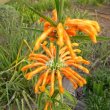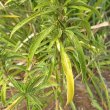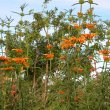| Botanical Name |
Leonotus leonuris variety or sub species |
| Family |
Lamiaceae - The mint and salvia family |
| Pronunciation |
lee-oh-NO-tis lee-oh-NOR-uss |
| Common Name(s) |
|
| Plant Group |
- Shrub A woody plant of relatively low height, having several stems arising from the base and lacking a single trunk; a bush.
|
| Plant Size |
- Medium
| Tree | 10m to 16m |
| Shrub | 1m to 2m |
| Perennial/ground cover | 40cm to 60cm |
| Bulb | 40cm to 60cm |
| Succulent | 40cm to 60cm |
|
| Position |
- Sun The area is in full sun for all or most of the day, all year round.
|
| General Information |
- Deciduous to Semi-deciduous In warmer areas a deciduous plant may not lose its leaves during winter at all, or may lose its leaves for a very brief period, or may only lose part of its foliage.
- Drought Tolerance: High The plant is well adapted to arid conditions; it can survive long periods of drought and high temperatures without extra water.
- Frost: Hardy The plant can withstand freezing temperatures or frost without artificial protection.
- Prune hard after flowering Fast growing shrubs that grow lanky within a season. Cut off branches and stems of these plants to a third of their original length. This will increase the yield of flowers, improve the plants shape and enhance the structural strength of main branches.
- Sand tolerant Plants adapted to survive in nutrient poor, very sandy soils.
- Water Wise Plant species originating from low rainfall regions that require less water to survive and thrive than other plant species.
- Wind Tolerant Plants able to withstand the effect of strong winds.
|
| Specific Information |
This is an unusual Leonotus that I have not seen anywhere else. The leaves are longer and narrower than those of Leonotus leonuris var. leonuris, and it does not seem to grow quite as large. The flowers are interesting because the calyxes are white with green stripes.
|
| Ad Break |
|
| Flowers |
| Description |
compact cluster of furry, tube-shaped flowers
|
| Season |
- Autumn to Winter Plants will seldom bloom for the entire season as given in the list, but should flower during a period within these parameters.
|
| Colour |
|
| Growth Rate |
- Moderate to Fast Specifying growth rate can be very misleading as there is considerable variation of growth rate depending on type and species of plant, available water, supplementary feeding, mulching and general care, as well as the plants suitability and adaptability to the garden environment.
|
| Plant Uses |
- Attracts bees, butterflies or other insects This plant attracts insects which can be food for birds or other creatures in your garden.
- Attracts Birds This plant will attract birds.
- Border A strip of ground, at the edge of a driveway or path in which ornamental plants or shrubs are planted.
- Boundary A plant useful for planting around the edges of the property to form a green or colourful backdrop, an impenetrable hedge, to hide walls or create privacy.
- Filler Either a fast growing tree or shrub used temporarily to fill in an area while the permanent plants grow to a desired size, or a plant used to fill gaps in borders or beds.
- Pioneer for new gardens A very fast growing plant, able to withstand hardship, that can be used to populate land that has recently been cleared of natural vegetation. These plants pave the way for slower-growing species by adding nutrients to the soil and creating leaf litter.
- Rock Garden An area constructed of larger rocks, arranged naturally, to emphasise the use of stones as a main element. Generally plants used do not need a lot of care.
- Suitable for coastal gardens Plants adapted to dry, sandy soil, forceful wind, limited rainfall and intense sunlight.
- Suitable for smaller gardens Such plants do not have invasive root systems, remain small or controllable and can often be grown in containers.
- Wild Garden An indigenous garden planted for the benefit of wildlife and birds. Provides food, water, a variety of mini-biomes and no poisonous chemicals are used.
|
| Distribution and Habitat |
|
| Planting Suggestions |
Plant in well-drained soil with a little compost. Mulch to retain moisture. To form a dense shrub and encourage flowering, tip off the growing points periodically during spring and early summer. Prune back hard at the end of winter.
|
| Medicinal Uses |
Probably the same as for Leonotus leonitis var. leonitis, namely for treating fevers, headaches, coughs, dysentery, snake bite, haemorrhoids and stomach ache, and as a purgative.
|
| Ad Break |
|









Comments
sub species?
I have had this plant given to me 3 years ago, have been trying to name it ever since.
The first photo in your series of 5 have the flower perfectly pictured. A globe ranging from golf to tennis ball size. The stalks grow to 9 feet (2.75 Meters)here on the coast of South Carolina, USA. It is almost a weed and is definitely an appreciated nuisance. Pops up anywhere on the property for 9 months of the year.
I Have only seen butterfly's and a very few bee's frequenting the plants.
They seem to be deer resistant, deer do not even sample it.
Bob
Discuss this plant
Share knowledge, ask a question or give an experience.